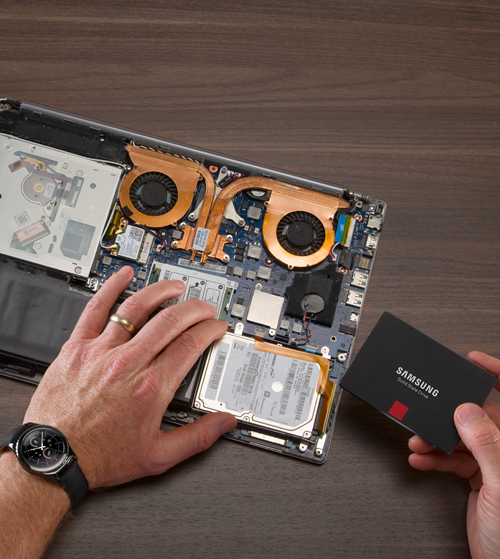Many of today’s innovations in healthcare technology help strengthen patient care, including the use of edge computing — a computing framework that involves processing data closest to the device that generates it — at hospitals, clinics and in patients’ own homes. Edge computing enables healthcare organizations to deploy other emerging technologies, such as artificial intelligence (AI), robot-assisted surgeries, and automated and remote patient monitoring to further improve patient outcomes. With everything from electronic medical records, bedside vital signs monitors, imaging systems and other connected devices generating massive amounts of data, there is a need for healthcare providers to bring computing power and storage closer to end users.
Solid state drives (SSDs) — which are faster, quieter and more reliable than traditional hard disk drives (HDDs) — are a building block for these healthcare technological advances at the edge. For example, a hospital’s edge server or edge data center can process, analyze and store data where it is generated instead of moving the data off-site to a centralized corporate data center or the cloud storage solution. This can eliminate network latency issues, enable quicker access to data, improve security and reduce bandwidth usage, in turn reducing overall costs.
Edge computing provides doctors with faster insights that can improve health outcomes when minutes and seconds count. According to an April 2021 report by analyst firm IDC, 46% of the healthcare IT leaders surveyed said that network latency needs to be less than 5 milliseconds for their organization’s edge computing initiatives.
Prepare for your storage upgrade
Which form factors and interfaces make the most sense for your company's storage needs? Download Now
The healthcare edge can be in different locations depending on specific use cases: a hospital or clinic, an operating room or department within a hospital, or even an ambulance. With the COVID-19 pandemic accelerating the adoption of telehealth and home healthcare, according to Home Health Care News, the edge can also be in people’s homes.
The following are some of the healthcare innovations at the edge that can take advantage of SSDs.
AI in imaging systems
Healthcare providers are beginning to train AI algorithms to analyze clinical images (X-rays, ultrasounds and MRIs) to assist radiologists in diagnosing their patients. Hospitals have begun to upgrade their picture archiving and communications systems (PACS) with an all-SSD storage solution. They are also using AI at the data center to analyze the images and alert radiologists of potential cancer and other diseases.
In some cases, healthcare organizations are using imaging systems with built-in AI capabilities. For instance, a mobile X-ray machine that uses a computer with SSD storage running AI tools can analyze X-rays, spot anomalies and overlay imaging with a color-coded heat map that shows the location of a lesion.
SSD- powered imaging systems using AI can help clinicians review and diagnose their patients more quickly and accurately. By 2026, 65% of medical imaging workflows will take advantage of AI to detect diseases and guide clinical intervention, according to IDC.
Robotic surgery systems
Computerized systems can include surgeon-controlled robotic arms and surgical instruments with cameras. They provide doctors with sharp, magnified views of the surgical area, which allows them to perform minimally-invasive surgery with precision and accuracy. SSDs are reliable and boost speed and performance of these robotic systems. Because the surgeons can make smaller incisions, their patients tend to have faster recovery times and shorter hospital stays, which can reduce the risk of infection, according to UC Health.
In the future, vendors are expected to incorporate AI into their robotic surgery systems to assist surgeons with decision-making, according to Healthcare IT News. For example, through video analysis and comparing thousands of other procedures, a robotic surgery system can analyze how well a surgeon sutured two blood vessels together and alert the surgeon about the probability of a leak.
Real-time diagnostics and remote patient monitoring
Hospitals can deploy software that can enable them to integrate patient information from EMRs, bedside vital signs monitors, images and laboratory tests. Through a single user interface, doctors and nurses can monitor patient health in real-time. The software uses predictive analytics and can warn clinicians of changes in patient status or potential problems.
In the future, edge computing will also allow paramedics to provide better care while they’re en route to a hospital, according to Computerworld. Paramedics can run diagnostic tests, check patients’ vital signs and take pictures. An edge computing device with SSD storage in the ambulance can analyze data and provide the paramedics with guidance on how to treat the patient effectively. This can also provide emergency room doctors with critical information to help them prepare for the patient’s arrival.
Healthcare providers are increasingly providing home healthcare services and using remote monitoring tools — such as consumer wearables, thermometers, blood pressure monitors and pulse oximeters — to monitor their patient’s vital signs. According to Computerworld, an edge computing device that stores data on an SSD in the home can use AI to analyze the patient data and detect whether a patient’s health has changed or if they may require clinician intervention.
Healthcare IT leaders say edge computing adoption in healthcare is still in its early stages, but they are increasing investments in edge computing initiatives. According to the same recent IDC study, almost half (46%) of healthcare organizations are planning to invest in edge computing within the next year.
Read more about how SSDs can help manage and secure data in healthcare. Learn how over-provisioning of SSDs can improve memory performance in this free white paper.








